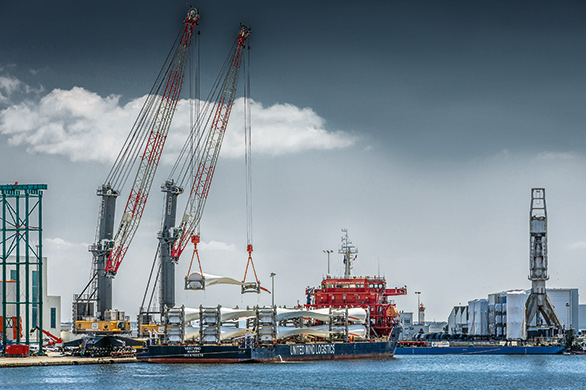Maritime cranes
Total turnover in the maritime cranes product segment amounted to € 740 million in 2021, representing a € 55 million or 6.9 % decrease year-on-year.
Development compared to previous year |
|
|---|---|
|
Turnover in € m
from 795 |
( - 6.9% ) 0 |
|
Investments in € m
from 17 |
( + 5.9% ) 0 |
|
Employees
from 3,750 |
( - 1.9% ) 0 |
Turnover by sales regions
-
European Union29.8%
-
North America10.1%
-
Central and South America7.8%
-
Non-EU countries14.2%
-
Asia and Oceania17.8%
-
Africa, Near and Middle East20.3%

Challenging market for maritime goods handling
In 2021, the coronavirus pandemic continued to influence the development of the maritime goods handling market and caused economic uncertainties worldwide. This resulted in strained supply chains, high raw materials prices, shortages in components and logistics bottlenecks, which affected all of Liebherr’s product segments.
The individual product areas in the maritime cranes product segment developed quite differently. In the area of mobile harbour cranes, Liebherr expanded its market share as world market leader and increased turnover compared to the previous year. There was also moderate growth recorded in the ship cranes product area. The consequences of the pandemic and difficult market conditions impacted container handling turnover in 2021, but a return to normality and increased sales have improved the outlook going forward.
Overall, business development in the maritime cranes product segment was unable to match the level of the previous year. Nevertheless, turnover increased in Central and South America, and Africa and the Near and Middle East, driven particularly by pleasing results in Brazil, Oman and the Ivory Coast. In the EU, the strongest sales market for the product segment, declines were recorded in Germany, among others. Increases in Slovenia, Spain and Sweden could not compensate for this. In the non-EU countries, Liebherr experienced the most notable sales decline in Russia. Despite growth impulses from individual markets in Asia and Oceania, the declines in China, Australia and New Zealand could not be compensated.
The use of the latest technologies for remote control and automation along with Liduro drives increases safety, consistency of operation and productivity at customers’ terminals worldwide.
Focus on alternative drives and digitalisation
One of the focal points in the reporting period was the development of products with alternative drives. A highlight was the LHM 420, the first mobile harbour crane which is operated with fossil-free diesel made from 100% renewable raw materials (HVO100 diesel) and thus enables efficient and locally emissions-free goods handling. In the area of general purpose offshore cranes, the delivery of several cranes from the ram luffing knuckle boom crane series marked another milestone. One of the cranes, an RL 2600- 35 Litronic, is being used for supply and maintenance tasks on an unmanned offshore platform in the DolWin 5 wind farm in the North Sea. In the reporting period, the product segment also focused on the further implementation of technologies in the areas of predictive maintenance and machine health. In view of the travel restrictions, the technologies for remote access and commissioning have been developed even faster and more specifically.
Despite a difficult market environment, Liebherr expects the maritime cranes product segment to grow in 2022. Any economic forecast for the year ahead must be treated with due caution, considering the war in Ukraine.
